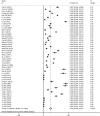Prevalence of short stature among children in China: A systematic review
- PMID: 34179712
- PMCID: PMC8212717
- DOI: 10.1002/ped4.12233
Prevalence of short stature among children in China: A systematic review
Abstract
Importance: The prevalence and characteristics of short stature (SS) among children in China should be assessed to provide guidance for planning and implementation of nationwide public health policies. Thus far, there have been no accurate estimates of the prevalence of SS in China.
Objective: To analyze the prevalence of SS among children in China and to explore the influences of sex, area, age, study year, and study site on prevalence rates.
Methods: Relevant literature was identified by searching the following databases: PubMed, Embase, The Cochrane Library, Chinese Biomedical Literature, China Knowledge Resource Integrated, WeiPu, and WanFang databases. Meta-analysis was carried out using STATA 11.2.
Results: This meta-analysis included 39 studies with 348 326 Chinese participants; the studies covered 20 provinces, municipalities, and autonomous regions. The pooled prevalence of SS was 3.2% (95% confidence interval [CI], 2.6%-3.7%; I 2 = 99.8%). The prevalence of SS in boys and girls were 3.1% (95% CI, 2.5%-3.7%) and 3.2% (95% CI, 2.6%-3.9%), respectively. The sex difference was not statistically significant (P > 0.05). The prevalence of SS was higher in rural areas than in urban areas (4.7% [95% CI, 3.6%-5.8%] vs. 2.8% [95% CI, 2.2%-3.4%]; P < 0.001). The prevalence of SS was higher in West China (5.2%; 95% CI, 4.4%-6.0%) than in Northeast China (0.6%; 95% CI, 0.3%-0.8%), East China (2.3%; 95% CI, 1.9%-2.8%), or Central China (2.9%; 95% CI, 1.9%-3.9%).
Interpretation: The prevalence of SS among children was higher in western and rural areas of China. Close attention to children's growth and development is needed to prevent the occurrence of SS.
Keywords: China; Meta‐analysis; Prevalence; Short stature.
© 2021 Chinese Medical Association. Pediatric Investigation published by John Wiley & Sons Australia, Ltd on behalf of Futang Research Center of Pediatric Development.
Conflict of interest statement
The author declare no conflicts of interest.
Figures
Similar articles
-
Spatial and demographic disparities in short stature among school children aged 7-18 years: a nation-wide survey in China, 2014.BMJ Open. 2019 Jul 16;9(7):e026634. doi: 10.1136/bmjopen-2018-026634. BMJ Open. 2019. PMID: 31315860 Free PMC article.
-
[Intake of main food among the children aged 6-17 years in different regions of China in 2019-2021].Wei Sheng Yan Jiu. 2023 Jan;52(1):67-78. doi: 10.19813/j.cnki.weishengyanjiu.2023.01.012. Wei Sheng Yan Jiu. 2023. PMID: 36750332 Chinese.
-
[Epidemic status and secular trends of malnutrition among children and adolescents aged 7-18 years from 2005 to 2014 in China].Beijing Da Xue Xue Bao Yi Xue Ban. 2017 Jun 18;49(3):424-432. Beijing Da Xue Xue Bao Yi Xue Ban. 2017. PMID: 28628142 Chinese.
-
Early Childhood Neglect Among 3- to 6-Year-Old Children in China: A Meta-Analysis.Trauma Violence Abuse. 2023 Jan;24(1):3-14. doi: 10.1177/15248380211013139. Epub 2021 May 4. Trauma Violence Abuse. 2023. PMID: 33942678 Review.
-
Incidence and prevalence of pressure injuries in children patients: A systematic review and meta-analysis.J Tissue Viability. 2022 Feb;31(1):142-151. doi: 10.1016/j.jtv.2021.07.003. Epub 2021 Jul 19. J Tissue Viability. 2022. PMID: 34312030
Cited by
-
[Early diagnosis and intervention for prepubertal short stature children].Zhongguo Dang Dai Er Ke Za Zhi. 2024 Jun 15;26(6):553-558. doi: 10.7499/j.issn.1008-8830.2312103. Zhongguo Dang Dai Er Ke Za Zhi. 2024. PMID: 38926370 Free PMC article. Review. Chinese.
-
Long-Term Efficacy and Safety of Growth Hormone in Children Suffering from Short Stature in China (CGLS): An Open-Label, Multicenter, Prospective and Retrospective, Observational Study.Adv Ther. 2025 Jun;42(6):2957-2969. doi: 10.1007/s12325-025-03146-2. Epub 2025 Apr 8. Adv Ther. 2025. PMID: 40198521 Free PMC article.
-
Global trends in recombinant human growth hormone for the treatment of idiopathic short stature: a bibliometric analysis.Front Med (Lausanne). 2025 Aug 6;12:1577396. doi: 10.3389/fmed.2025.1577396. eCollection 2025. Front Med (Lausanne). 2025. PMID: 40842547 Free PMC article.
-
[Attaching great importance to the scientific assessment of short stature in children].Zhongguo Dang Dai Er Ke Za Zhi. 2023 Nov 15;25(11):1095-1100. doi: 10.7499/j.issn.1008-8830.2308063. Zhongguo Dang Dai Er Ke Za Zhi. 2023. PMID: 37990451 Free PMC article. Chinese.
-
[Pharmacological therapies for height improvement in pubertal children with short stature].Zhongguo Dang Dai Er Ke Za Zhi. 2024 Feb 15;26(2):118-123. doi: 10.7499/j.issn.1008-8830.2309125. Zhongguo Dang Dai Er Ke Za Zhi. 2024. PMID: 38436307 Free PMC article. Chinese.
References
-
- Genetic metabolic endocrine group of pediatrics branch in Chinese Medical Association . Guidelines for diagnosis and treatment of children with short stature. Chin J Pediatr. 2008;46:428‐430. (in Chinese) - PubMed
-
- Zlotkin D, Varma SK. Psychosocial effects of short stature. Indian J Pediatr. 2006;73:79‐80. - PubMed
-
- Kranzler JH, Rosenbloom AL, Proctor B, Diamond FB Jr, Watson M. Is short stature a handicap? A comparison of the psychosocial functioning of referred and nonreferred children with normal short stature and children with normal stature. J Pediatr. 2000;136:96‐102. - PubMed
-
- Wheeler PG, Bresnahan K, Shephard BA, Lau J, Balk EM. Short stature and functional impairment: A systematic review. Arch Pediatr Adolesc Med. 2004;158:236‐243. - PubMed
LinkOut - more resources
Full Text Sources


